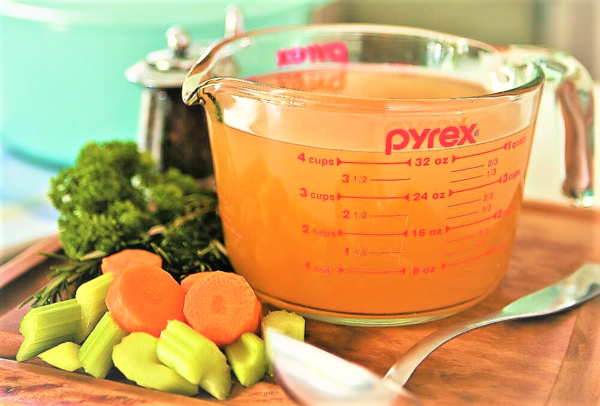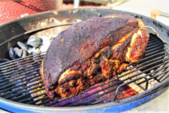
3 Steps to Perfect Turkey Gravy
Chef Perry P. Perkins
Stock vs. Broth
First, let’s make sure that we’re all on the same page, as far as what constitutes a “broth.”
Many, many home cooks assume that “stock” and “broth” are the same thing: a savory liquid simmered with veggies, meat scraps, and bones, to be used as the base for soups, sauces, etc.
In truth, the steps for making stock are very similar to those of making broth but with just a few small but very important differences.
Stock is made by simmering a combination of animal bones (which typically contain some scraps of meat), mirepoix (onions, carrots, and celery), and aromatics in water for 6-8 hours.
Stock always involves animal bones, although not always meat. For best results, the bones are usually roasted first, which makes for a richer, more deeply colored stock. Most importantly...stock is always left unseasoned.
Broth, on the other hand, refers to any liquid that has had meat cooked in it. Simmering meat (and often roasted bones as well) with a mirepoix, and aromatics with water for (usually) less than two hours.
Quite the opposite of stocks, broths are typically well seasoned, creating a thin, flavorful liquid to be used in all the same ways you’d use stock, served as a dip, or even on its own.
Tip #1: The Broth
Spatchcock your turkey before you brine it (assuming that you’re going to brine), and roast the removed back-bone, wingtips, giblets, and trimmed fat, along with a little salt and chopped onions while the bird’s brining. This gives you the prepared basics for your broth with them being overly salty from the brine.
Never plan to use pan drippings (unless heavily diluted) from a turkey that’s been brined. The reduction in the liquids during cooking makes the drippings super salty and nearly inedible.
The Recipe of Broth:
- 2 whole turkey thighs and/or necks, skin on
- Salt and pepper
- 6 cloves of peeled garlic
- 2 tsp. whole peppercorns
- 1/2 cup butter
- 1 lg. yellow onion, peeled and quartered
- 4 stalks of celery, roughly chopped
- 2 lg. Carrots, roughly chopped
- 1 stalk each: rosemary, sage, thyme
- 2 bay leaves
- 8 cups of water
Preheat over to 350F
Sprinkle thighs, backs, etc., with salt and pepper. And roast about 40 minutes, until skin is a deep golden brown.
Meanwhile, melt butter in a heavy bottom stock pot over medium heat. Add peppercorns and garlic and sauté a couple of minutes, stirring, to infuse the butter. Add onion, celery, and carrots, and sauté until carrots begin to brown.
Add water and bring to a simmer.
Add fresh herbs (whole) and bay leaves.
Add roasted turkey thighs.
Simmer uncovered, until liquid is reduced by 1/2. Strain your stock and discard the herb, skin, and veggie remnants.
Roughly chop the meat, and return it to the stock. Taste, and add salt and pepper to your liking.
Make your stock from those roasted ingredients (you can also buy a couple of turkey thighs, and roast them if you like a “meaty” gravy…which I do!) This allows you to season your broth to taste, and defat it (if you choose) while the turkey is roasting, so you can start your dressing and gravy before the bird is done.
Tip #2: The Roux
Always start your gravy by making a roux (equal parts fat and cooked flour, thinned with broth.)
The darker you cook your roux, the deeper the flavor of your gravy. Once your roux has cooked to your liking, thin it to gravy using your fresh broth.
All of these instructions are exactly the same when roasting chickens, btw, so you can use these tips all year-round.
The Recipe of Roux
- 1/2 cup (1 stick) sweet cream butter
- 1/2 cup AP Flour
Melt your butter in a heavy bottom stockpot over medium heat.
When the foam has cooked off the butter, add flour and whisk vigorously to a smooth paste. This is call a "roux."
Continue whisking slowly until the roux becomes deep brown in color. You know when your roux is done by the roasted nutty smell.
Tip #3: The Gravy
Makes 10-12 generous servings
Roux (recipe above)
- 4 cups hot homemade turkey broth (recipe above)
- 2-4 cups boiling water*
Once your roux has reached your desired color, add hot broth, one cup at a time (the first will create a thick paste...press on) whisking in each until smooth.
Once all your broth in incorporated, keep whisking at a lower simmer for 10-15 minutes.
Add hot water (again, a cup at a time) until you reach the desired consistency.
Taste and add salt and pepper as desired.
*You can also use milk, just make sure it's hot. Rule of thumb - never add cold liquid to a hot one (especially milk, as it will curdle) there are those who would argue this step (believe me!) but it’s never failed me.
Chef’s Tip: Just before serving, I like to whisk a couple of tablespoons of Sweet Cream Butter into my gravy, which gives is a glossy appearance and silky texture.
Enjoy!
Chef Perry

































